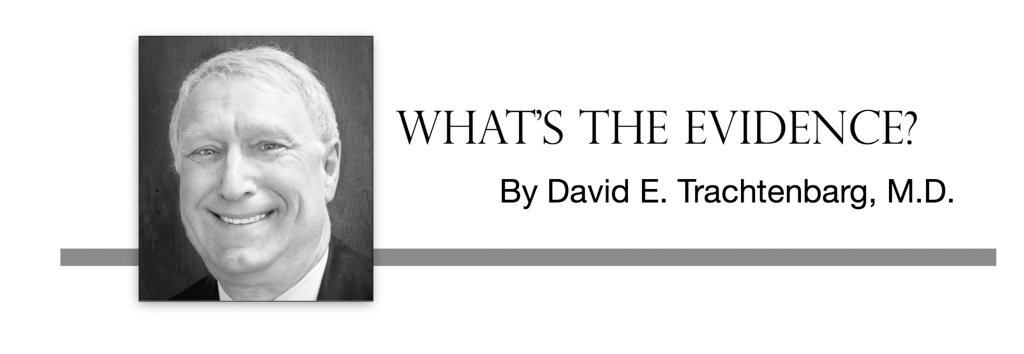There is good evidence to support breast cancer screening, but there is controversy about which screening method is best. An ideal cancer test would never indicate a cancer that was not present (false positive) and never miss a cancer (false negative). For standard mammograms there is a 7.5 percent chance of a false positive test leading to additional testing, and there is a 20 percent chance of missing a cancer on a mammogram. Radiation is another risk from mammography and is estimated to cause one breast cancer for every 1,000 women.
Breast Examination
Many if not most women would be love to avoid the hassle and expense of mammograms. Unfortunately, most healthcare providers have stopped teaching self-breast examination because it does not reduce the risk of dying from breast cancer. For clinical breast examination by a medical provider, a recent study from Canada of 89,835 patients concluded there was no difference between clinical exam alone and mammography for women 40-59 years of age.1 However, experts question this study because of the quality of the mammograms and the number of women scheduled to have only clinical breast examinations who also had mammograms.2 Even if there was no controversy, most experts would not recommend women stop doing mammograms without more studies.
Mammograms
There are three main methods to do a mammogram from least expensive to most expensive – using x-ray film, 2-D digital and 3-D digital. For women under 50, 2-D digital mammograms are better at detecting cancer than x-ray mammograms. For most women over 50, the results are equivalent.3 Because of this and living in the digital age, fewer mammograms are done using x-ray film each year.
3-D mammograms (digital tomosynthesis) represent the latest attempt to improve mammograms. In Peoria, both health systems offer this service. When a 3-D study is done, it is usually combined with a regular 2-D study or a 2-D study created from the digital information. The 3-D study finds more cancers, especially in women under 50. The false positive rate is also reduced meaning fewer women require additional testing.4 Because the cost of 3-D is higher and the test is newer, it is not covered by all insurances.
Other Tests
Ultrasound is good for evaluating some breast lumps found on examination and some abnormal mammograms. Ultrasound is not recommended to screen for breast cancer. Magnetic resonance imaging (MRI) is used to evaluate breast problems in individuals with specific situations such as breast implants. It is not advised for general screening. Standard computerized tomography (CT scan) has been used in the past for evaluating some patients with breast problems, but is being eliminated. 3-D mammography (digital tomosynthesis) uses the same technology to create the image and is designed for breast problems. Thermography senses infrared “hot spots” in the breast that could be cancerous. The evidence does not support using thermography for screening.
What to Do
One well researched guideline is the U.S. Preventive Services Task Force. They advise mammography every other year for women aged 50-74. Women under 50 and 75 or older should evaluate the risks and benefits for them. The Task Force does not advise teaching self-breast examination. 3-D mammograms appear to be a better test, however, cost, insurance coverage need to be considered.
Key References
NCI: http://www.cancer.gov/cancertopics/pdq/screening/breast/healthprofessional
NCI: http://www.cancer.gov/newscenter/qa/2005/dmistqandA
End Notes
- Miller AB, Wall C, Baines CJ, Sun P, To T, Narod SA: Twenty five year follow-up for breast cancer incidence and mortality of the Canadian National Breast Screening Study: randomised screening trial. BMJ 2014;348
- Nelson, R: Value of Mammography Questioned by Canadian Trial. Medscape. February 11, 2014 http://www.medscape.com/viewarticle/820468#vp_2
- Pisano E, Gatsonis C, Hendrick E, Yaffe M, Baum J, Acharyya S, Conant E, Fajardo L, Bassett L, D’Orsi C, Jong R, and Rebner M. Diagnostic Performance of Digital versus Film Mammography for Breast Cancer Screening – The Results of the American College of Radiology Imaging Network (ACRIN) Digital Mammographic Imaging Screening Trial (DMIST). N Engl J Med 2005; 353:1773-1783
- Houssami N, Macaskill P, Bernardi D, Caumo F, Pellegrini M, Brunelli S, Tuttobene P, Bricolo P, Fantò C, Valentini M, Ciatto S: Breast screening using 2D-mammography or integrating digital breast tomosynthesis (3D-mammography) for single-reading or double-reading–evidence to guide future screening strategies. Eur J Cancer. 2014 Jul;50(10):1799-807. doi: 10.1016/j.ejca.2014.03.017. Epub 2014 Apr 17.

